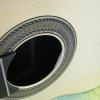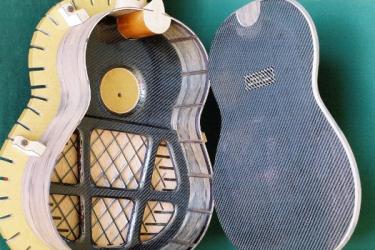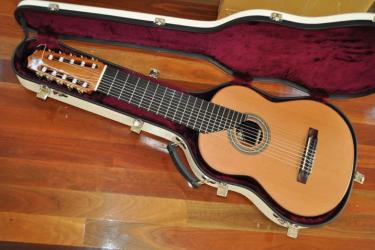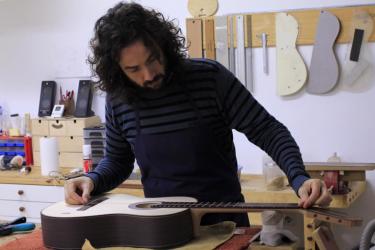
I’m delighted to have Richard Newman from Berkshire, UK.
Q1. Could you please tell us a little about your luthiery and its history?
I have always had a strong connection to working with wood. When I was 12 years old I would build wooden objects such as spice racks, chairs and tables and sell them to neighbours in our street.
On leaving school I got a job maintaining and felling trees. During my free time, a guitar would always be on my knee, I suppose it was inevitable that I would eventually end up building one, but I didn't envisage that this would lead to career making guitars. After building a few instruments, I decided I would enrol in a full time guitar making course at the London guildhall university.
Q2. Please describe your idea of a good sounding guitar, and what you do to achieve it?
Everyone has a different idea of what a good sounding guitar should be. Their decision may arise from what type of guitar they were exposed to, while becoming interested in the classical guitar. For myself, the 1994 recording Wulfin Lieske plays Isaac Albeniz, is what captured me. On this recording Wulfin plays an 1888 guitar made by Antonio de Torres. It is this old earthy sound, with deep, dark, qualities, that I try to capture in my own instruments. Over the years I have experimented, using different bracing systems, only to return to the traditional fan braced guitar. The beauty of this uncomplicated system is when you get it right it is capable of producing the most wonderfully intricate and pure qualities.
Q3. Please tell us about your idea of improving playability, and what you do to achieve it?
Playability can be contributed to the neck profile, action, correctly dressed frets, tension of the top. More importantly, it arises from what the player wants and how his/her requirements can effect playability and tone.
Q4. Please tell us your opinion about the traditional finishing method (French polish) and new methods (lacquer, catalysed finishing, etc).
I only have experience of the traditional method of French polishing, using shellac. The newer, modern finishes do not really interest me, and as yet I have never had a player requiring anything other than shellac.
Q5. Please tell us your opinion regarding shorter-scale guitars such as 640, 628 and 615mm in terms of playability, design, sound quality and volume. Is there an increasing need to cater to smaller-handed or female players?
I have built a few short scale guitars, the shortest being 630mm. Design elements such as smaller body proportion, bridge placement, and top thickness, are the key areas to creating a successful small scale/bodied guitar without any deficiency of volume or tone. 640mm guitars are now becoming very popular, with many makers building them, but they are really only 5mm shorter than standard, if consider 1st to 12th fret. For very small hands the 615mm maybe the way to go. I have heard some that are very warm and focused, but achieving a big guitar sound, maybe more of a challenge.
Q6. Many readers say they end up being very confused after trying many guitars. Could you give us some advice on how to examine the guitars' sound quality and playability at a shop or luthier, from the guitar-maker's point of view?
There has probably never been a better time to buy a guitar, with so many makers producing fine quality guitars. I am just glad it is not me having to choose. If it was me, I would hope i would know instantly that "this is the one".
Q7. Do you offer any 'after-sales' service to customers - particularly customers who are nervous about making a substantial investment?
Yes, most definitely. All workmanship is fully guaranteed. Also, I try to make the customer fully aware of how to care for the guitar, such as cleaning and environmental care.
Q8. How does the increasing rarity of some woods, rosewood for example, impact on your methods, and the quality of the end product?
I have found that players are not so "stuck in the mud" as in the past. Players are more willing to accept the makers choice of woods, without insisting on a traditional rosewood. There are many timbers that are not endangered out there, that make very good sounding guitars. I think if the wood is pretty, environmentally stable, plentiful, and the guitar sounds very good, then I don't see a problem.






